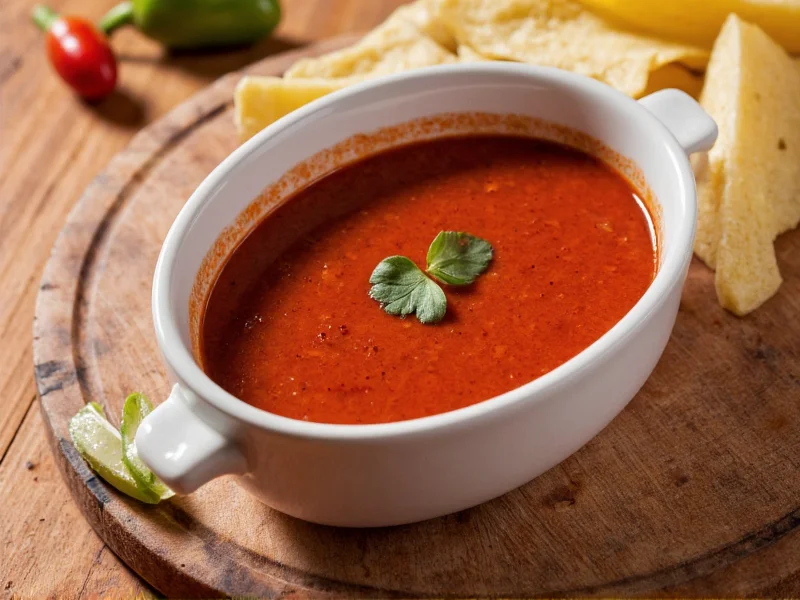Guajillo sauce represents one of Mexico's most versatile culinary staples, crafted from dried mirasol peppers that transform when rehydrated into a complex sauce balancing fruitiness with subtle heat. Unlike many chili sauces that prioritize burn over flavor, guajillo delivers a sophisticated profile featuring notes of green tea, cranberry, and roasted pepper that enhances rather than overwhelms dishes. This distinctive characteristic makes it indispensable in authentic Mexican cooking where flavor complexity matters more than pure spiciness.
Understanding Guajillo Peppers and Sauce Composition
Guajillo peppers (Capsicum annuum) rank as Mexico's second most popular chili after jalapeños. When dried and processed into sauce, they create a smooth, pourable liquid with distinctive characteristics:
| Characteristic | Details |
|---|---|
| Heat Level | Mild to medium (2,500-5,000 Scoville units) |
| Flavor Profile | Tangy, berry-like, with hints of green tea and tamarind |
| Color | Bright brick-red to deep mahogany |
| Texture | Smooth, slightly viscous when properly strained |
| Traditional Ingredients | Rehydrated guajillo peppers, garlic, cumin, Mexican oregano, broth |
Authentic Preparation Method
Creating authentic guajillo sauce requires attention to detail that transforms simple ingredients into culinary magic. Professional chefs emphasize these critical steps for optimal results:
- Pepper selection: Choose plump, flexible guajillo peppers without cracks (stale peppers yield bitter sauce)
- Proper rehydration: Soak peppers in hot (not boiling) water for exactly 15-20 minutes to preserve flavor compounds
- Seed management: Remove most seeds to control heat while retaining flavor complexity
- Straining technique: Double-strain through fine mesh for restaurant-quality smoothness
- Balancing acidity: A splash of vinegar or lime juice brightens the earthy notes
Many home cooks make the mistake of overcooking guajillo sauce, which diminishes its delicate fruit notes. The ideal preparation involves blending rehydrated peppers with aromatics then simmering gently for no more than 10 minutes to preserve volatile flavor compounds.
Culinary Applications and Pairings
Guajillo sauce's versatility extends far beyond basic enchilada preparation. Understanding proper pairings elevates your Mexican cooking:
- Protein compatibility: Perfect with chicken, pork, and fish (avoids overwhelming delicate seafood like traditional chipotle would)
- Traditional dishes: Essential for mole de olla, chile colorado, and authentic enchilada rojas
- Modern applications: Excellent as pizza base, sandwich spread, or mixed into aioli for dipping sauces
- Flavor balancing: Complements sweet elements like plantains or roasted sweet potatoes
Chefs specializing in regional Mexican cuisine note that guajillo sauce serves as the foundation for many northern Mexican dishes where tomato-based sauces dominate central regions. This geographical distinction explains why authentic Sonoran cuisine features guajillo prominently in carne asada preparations.
Storage and Preservation Techniques
Proper storage maintains guajillo sauce's vibrant color and complex flavor profile. Follow these professional guidelines:
- Refrigerate in airtight container for up to 1 week (surface discoloration indicates oxidation)
- Freeze in ice cube trays then transfer to bags for 6 months of quality retention
- Avoid metal containers which react with the sauce's natural acidity
- When reheating, use gentle warming rather than boiling to preserve flavor integrity
Food scientists confirm that guajillo peppers contain antioxidants that help preserve the sauce's quality better than many other chili varieties. However, the addition of garlic and other aromatics reduces shelf life compared to plain rehydrated pepper puree.
Substitutions and Variations
When authentic guajillo peppers aren't available, understanding proper substitutions prevents recipe failure. Not all chili sauces work as direct replacements:
- Closest substitute: Ancho peppers provide similar fruitiness with less tang (use 2 parts ancho to 1 part pasilla for approximation)
- Avoid: Chipotle (smoky heat profile differs significantly)
- Commercial shortcut: Look for "salsa roja" with guajillo listed first in ingredients (many "Mexican red sauces" use cheaper peppers)
- Flavor adjustment: Add 1 tsp vinegar per cup to mimic guajillo's distinctive tang when using substitutes
Traditional Mexican cooks sometimes blend guajillo with small amounts of cascabel or pasilla negro peppers to create regional variations. This technique demonstrates how skilled cooks manipulate single-ingredient sauces into complex flavor profiles through thoughtful blending.
Frequently Asked Questions
What's the difference between guajillo sauce and regular red enchilada sauce?
Authentic guajillo sauce uses only guajillo peppers as the chili base, creating a distinctive tangy, berry-like flavor. Many commercial "red enchilada sauces" blend multiple cheaper peppers like New Mexico chilies with tomato products, resulting in a flatter, more one-dimensional taste without guajillo's complex fruit notes.
Can I make guajillo sauce without a blender?
Yes, though texture will differ. Traditional Mexican preparation sometimes uses a molcajete (lava stone mortar) to grind rehydrated peppers with garlic and spices. This method creates a slightly chunkier, more rustic sauce with enhanced flavor release from the grinding process, though it requires significant effort compared to modern blenders.
Why does my homemade guajillo sauce taste bitter?
Bitterness typically comes from over-soaking peppers (more than 25 minutes), using old or improperly stored dried peppers, or including too many seeds and veins. To fix bitter sauce, add 1/4 teaspoon of sugar or a small piece of carrot while simmering, which neutralizes bitterness without making the sauce sweet.
Is guajillo sauce gluten-free and vegan by default?
Traditional guajillo sauce preparation is naturally gluten-free and vegan, containing only peppers, water, and seasonings. However, commercial versions sometimes add thickeners or flavor enhancers that may contain gluten or animal products. Always check labels if dietary restrictions apply, and homemade versions guarantee purity when using whole ingredients.
How can I adjust guajillo sauce heat level without changing flavor?
Control heat by adjusting seed content during preparation - more seeds increase heat with minimal flavor change. For finished sauce, add small amounts of honey (1/4 tsp at a time) which counteracts capsaicin without altering flavor profile significantly. Avoid dairy additions as they change the sauce's fundamental character and limit its culinary applications.











 浙公网安备
33010002000092号
浙公网安备
33010002000092号 浙B2-20120091-4
浙B2-20120091-4